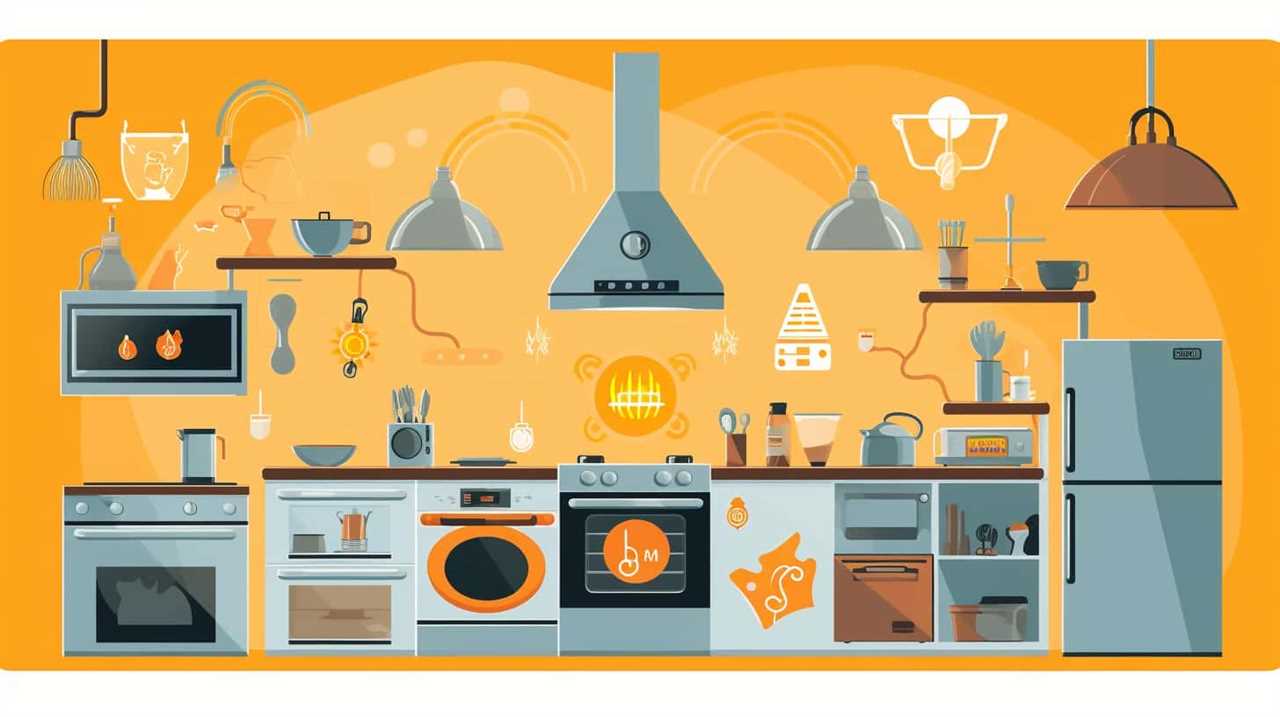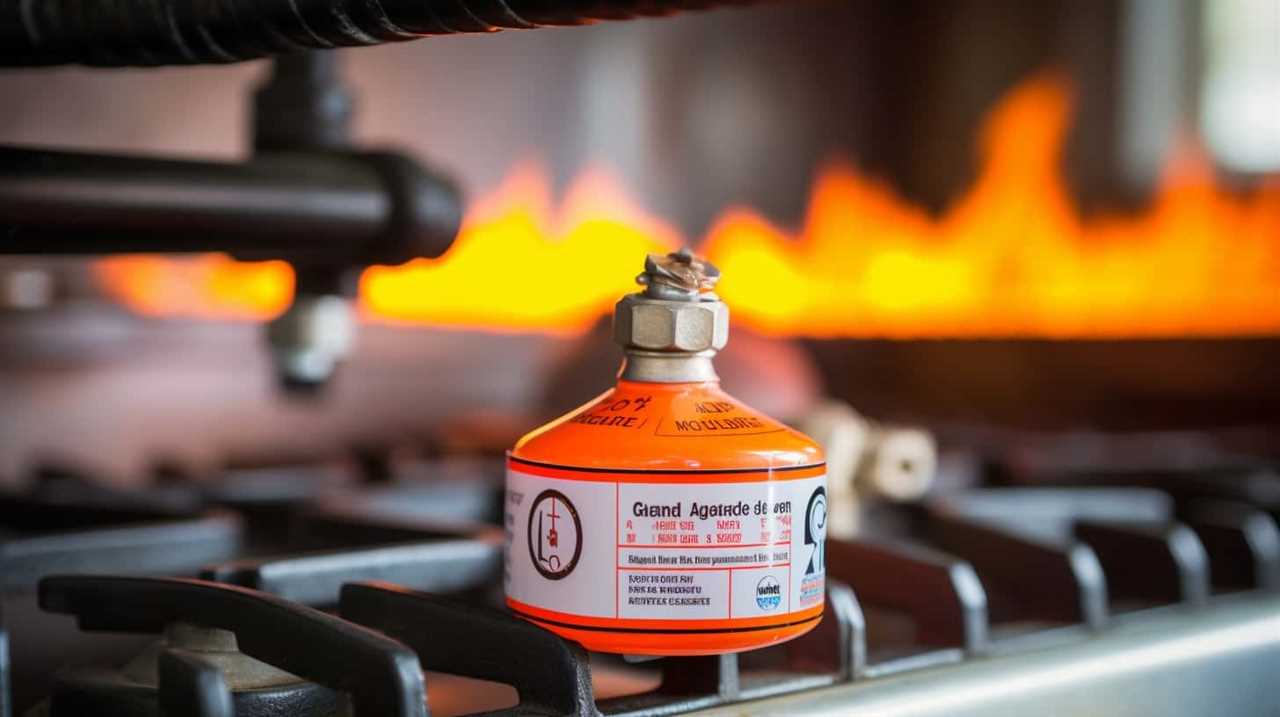So, you recently purchased a new household appliance, right? Well, I have to warn you, it’s not all smooth sailing. If you’re not cautious, that new shiny device could become a risky ticking time bomb.
But fear not, my friends, because we are here to guide you through the essential steps of securing home appliance safety. We’ll show you how to identify potential hazards, check for safety certifications, and properly install and maintain your appliances.
We’ll even teach you how to childproof them and protect against electrical hazards. So, buckle up and get ready to master the art of home appliance safety. It’s time to take control and ensure a secure and worry-free home environment.
Let’s get started!

Key Takeaways
- Regularly inspect electrical systems and address issues promptly
- Use surge protectors and avoid extension cords for high-powered appliances
- Safety certifications provide assurance of rigorous testing and meeting safety standards
- Proper installation procedures and regular maintenance are essential for appliance safety
Understanding Appliance Hazards
Understanding appliance hazards is crucial for ensuring the safety of our homes. By being aware of the potential dangers associated with household appliances, we can take proactive steps to prevent accidents and protect our loved ones.
To achieve this, it’s essential to implement appliance safety measures and familiarize ourselves with the common hazards that can arise.
One common hazard is electrical malfunctions. Faulty wiring or overloaded circuits can lead to electrical fires or electrocution. To mitigate this risk, it’s important to regularly inspect the electrical systems in our homes and promptly address any issues. Additionally, using surge protectors and avoiding the use of extension cords for high-powered appliances can help prevent electrical mishaps.
Another hazard to consider is improper usage. Misusing appliances, such as using a microwave to dry clothes or overloading a washing machine, can result in damage or even injury. It’s crucial to carefully read the instruction manuals and follow the recommended guidelines for each appliance. Taking the time to properly educate ourselves on the correct usage can greatly reduce the risk of accidents.

Furthermore, inadequate maintenance can also pose a hazard. Neglecting to clean or service appliances can lead to malfunctions or even breakdowns. Regularly cleaning filters, coils, and vents, as well as scheduling professional maintenance checks, can help prolong the lifespan of our appliances and prevent potential hazards.
Checking for Safety Certifications
To ensure the safety of our homes, we must first prioritize checking for safety certifications on our household appliances. Safety certifications provide consumers with the assurance that the appliance they’re purchasing has undergone rigorous testing and meets the necessary safety standards.
Here are three key reasons why checking for safety certifications is crucial:
- Peace of Mind: Safety certifications such as UL (Underwriters Laboratories) or CSA (Canadian Standards Association) indicate that the appliance has been thoroughly tested for potential hazards. By choosing appliances with these certifications, we can have peace of mind knowing that they’ve met the necessary safety requirements.
- Prevention of Accidents: Safety certifications help to prevent accidents and injuries caused by faulty appliances. Appliances without proper certifications may have design flaws or manufacturing defects that can pose serious risks to our homes and families. By checking for safety certifications, we can avoid potential hazards and ensure the well-being of our loved ones.
- Long-Term Cost Savings: Investing in appliances with safety certifications can save us money in the long run. Certified appliances are less likely to malfunction or cause electrical problems, reducing the risk of costly repairs or replacements.
Proper Installation Procedures
Now let’s focus on how we can ensure the proper installation of our home appliances. Following installation guidelines is crucial to ensure the safety and optimal functioning of our appliances. To start, it’s important to read the manufacturer’s instructions carefully and follow them step by step. These instructions provide specific guidance on the correct installation procedures for each appliance.

One common installation mistake isn’t properly leveling the appliance. This can cause imbalance, leading to noise, vibration, and even damage to the appliance. It’s also important to ensure that all electrical connections are secure and that the appliance is grounded properly. Failure to do so can result in electrical hazards or malfunctions.
Another common mistake isn’t allowing for proper ventilation. Appliances such as refrigerators, dryers, and ovens require adequate airflow to prevent overheating. Failure to provide sufficient ventilation can lead to decreased efficiency and potential damage to the appliance.
Regular Maintenance and Inspections
Regular maintenance and inspections are crucial for ensuring the safety and efficiency of home appliances.
Professional inspections provide a thorough assessment of potential issues and can help identify any safety hazards.

Additionally, there are simple DIY maintenance tips that homeowners can follow to keep their appliances in good working condition and minimize the risk of accidents.
Importance of Professional Inspections
At our company, we believe in the importance of regular maintenance and inspections by professionals for securing home appliance safety. Hiring professionals for inspections ensures that your appliances are assessed by individuals with the necessary professional expertise to identify potential issues and provide appropriate solutions. Here are three reasons why professional inspections are crucial:
- Expertise: Professionals have the knowledge and skills to thoroughly inspect your appliances, ensuring that they meet industry standards and are operating safely.
- Prevention: Regular inspections can help catch and address potential problems before they escalate, preventing costly repairs or accidents.
- Peace of Mind: Knowing that your appliances have been professionally inspected can give you confidence in their safety and reliability.
DIY Maintenance Tips
We recommend conducting regular, hands-on maintenance and inspections of your home appliances. DIY troubleshooting and maintenance can help ensure the safety and longevity of your appliances. Here is a handy appliance maintenance checklist to guide you:
| Appliance | Maintenance Tips |
|---|---|
| Refrigerator | Clean condenser coils, check door seals for leaks |
| Oven | Clean burners, check for gas leaks |
| Dishwasher | Clean filter, check for clogs |
| Washing Machine | Clean detergent dispenser, inspect hoses for leaks |
Performing these simple tasks regularly can prevent major issues and costly repairs. Additionally, it is important to refer to your appliance’s user manual for specific maintenance instructions. Regular maintenance not only ensures the efficient functioning of your appliances but also promotes safety in your home. So take the time to inspect and maintain your appliances regularly to keep them running smoothly and to avoid any potential hazards.

Safe Handling and Operation
When it comes to safe handling and operation of home appliances, there are a few key points to keep in mind.
First, it’s essential to familiarize ourselves with the proper usage techniques provided in the appliance’s user manual. This will help us understand how to operate the appliance safely and efficiently.
Second, preventing potential hazards is crucial, and this can be achieved by following all safety guidelines and recommendations provided by the manufacturer.
Lastly, we must always handle our appliances with care, ensuring that we avoid any rough handling or misuse that could potentially lead to accidents or damage.

Proper Usage Techniques
To ensure the safe handling and operation of home appliances, it’s important that we carefully follow proper usage techniques. By implementing these techniques, we can maintain the longevity and efficiency of our appliances while minimizing the risk of accidents.
Here are three essential practices to keep in mind:
- Proper cleaning techniques: Regularly clean your appliances according to the manufacturer’s instructions. This includes removing dust and debris from vents, filters, and coils. Clean the interior and exterior surfaces with appropriate cleaning agents to prevent the buildup of dirt and grime.
- Energy saving practices: Conserve energy by using appliances efficiently. Avoid overloading electrical outlets and unplug appliances when not in use. Opt for energy-efficient models and adjust settings to minimize energy consumption. Additionally, ensure proper insulation and maintenance of your appliances to avoid unnecessary energy wastage.
- Regular maintenance: Schedule regular maintenance checks for your appliances. This includes inspecting and replacing worn-out parts, lubricating moving components, and checking for any leaks or damage. Regular maintenance helps identify potential issues early on and ensures that your appliances continue to operate safely and efficiently.
Following these proper usage techniques won’t only enhance the performance of your home appliances but also contribute to a safer and more energy-efficient household.
Preventing Potential Hazards
One important step in securing home appliance safety is implementing proper handling and operation techniques. By following these techniques, you can prevent accidents and ensure user safety.

Firstly, always read the instruction manual thoroughly before using any appliance. This will provide you with important safety information and guidelines specific to that appliance.
Secondly, make sure to use the appliance only for its intended purpose and within its specified limits. Overloading or misusing an appliance can lead to malfunctions and accidents.
Additionally, always keep your appliances clean and well-maintained. Regularly check for any loose wires, frayed cords, or damaged parts, and have them repaired or replaced immediately.
Lastly, never leave an appliance unattended while it’s in use, and always turn it off and unplug it when not in use.

Handling With Care
Next, we’ll explore how to handle home appliances with care through safe handling and operation techniques.
When it comes to safe transportation of appliances, follow these tips:
- Always unplug the appliance before moving it to avoid electrical shock.
- Secure any loose parts or accessories to prevent damage during transportation.
- Use proper lifting techniques and seek assistance when necessary to avoid strain or injury.
In addition to safe transportation, it’s crucial to know the emergency procedures for each appliance. Here are a few key points to remember:
- Familiarize yourself with the location of the appliance’s emergency shut-off switch or power cord.
- Keep a fire extinguisher nearby in case of electrical or appliance-related fires.
- If an appliance malfunctions or emits strange odors, unplug it immediately and contact a professional for assistance.
Monitoring for Signs of Wear and Tear
We regularly inspect our home appliances for signs of wear and tear. Detecting early warning signs of wear and tear is crucial in ensuring the safety and longevity of our appliances. By monitoring our appliances closely, we can identify potential issues before they become major problems.

One of the most important things to look out for is any unusual noises or vibrations. These can indicate loose or worn-out parts, which may need to be repaired or replaced. Additionally, keep an eye out for any leaks, such as water or gas, as these can be signs of a faulty appliance that needs immediate attention.
Another key area to monitor is the electrical cords and plugs. Look for frayed or damaged cords, as well as loose plugs. These can pose a serious safety hazard and should be addressed promptly. It’s also essential to check the power outlets to ensure they’re in good condition and properly grounded.
Regularly cleaning and maintaining your appliances can also help prevent wear and tear. Dust and debris can accumulate over time, causing the appliance to work harder and potentially leading to damage. Therefore, it’s important to follow the manufacturer’s instructions for cleaning and maintenance.
Fire Prevention Measures
To prevent fires, it’s crucial that we implement proactive measures to safeguard our home appliances. Fire prevention techniques and fire safety precautions are essential to protect our homes and loved ones from the devastating effects of fire. Here are three key measures you can take to minimize the risk of fire in your home:

- Regular maintenance: Schedule regular inspections and maintenance for your home appliances. Check for any signs of wear and tear, loose wiring, or overheating. Replace damaged cords or faulty components immediately.
- Proper ventilation: Ensure that your appliances have proper ventilation to prevent overheating. Keep them clear of any flammable materials and avoid overcrowding them. Good airflow will help dissipate heat and reduce the risk of fire.
- Unattended appliances: Never leave your appliances unattended while they’re in use. Always turn off and unplug them when not in use, especially before leaving the house or going to bed. This simple habit can significantly reduce the chances of an electrical fire.
By implementing these fire prevention measures, you can greatly enhance the safety of your home and reduce the risk of fire-related incidents.
Now, let’s move on to the next section, where we’ll discuss how to protect against electrical hazards.
Protecting Against Electrical Hazards
To protect against electrical hazards, we must take proactive steps to ensure the safety of our home appliances. Electrical accidents can result in serious injuries or even fatalities, so it is crucial to implement proper electrical safety measures in our homes. By following these precautions, we can significantly reduce the risk of electrical accidents and promote a safe environment for ourselves and our loved ones.
One of the most effective ways to prevent electrical accidents is to regularly inspect and maintain our home appliances. This includes checking for frayed or damaged cords, ensuring that outlets are not overloaded, and keeping appliances away from water sources. Additionally, using surge protectors can help protect our appliances from power surges and voltage fluctuations.

Here is a table outlining some essential electrical safety measures:
| Electrical Safety Measures | Description |
|---|---|
| Regularly inspect appliances | Check for damaged cords or loose connections |
| Avoid overloading outlets | Plug only one high-wattage appliance into each outlet |
| Keep appliances away from water | Prevent potential electrocution |
| Use surge protectors | Protect appliances from power surges |
| Unplug appliances when not in use | Reduce the risk of electrical fires |
Childproofing Appliances
When it comes to childproofing appliances, there are several essential steps to take.
First, installing safety latches on ovens can prevent children from opening them and potentially getting burned.
Second, using outlet covers for appliances can help protect curious little hands from electrical shocks.

Lastly, locking dishwasher controls can prevent children from accidentally starting the appliance or opening it while it’s in operation.
Taking these precautions will go a long way in ensuring the safety of your children around household appliances.
Safety Latches for Ovens
We installed safety latches on our oven to childproof it. Childproofing devices are crucial for ensuring the safety of our little ones around home appliances. When it comes to oven safety features, safety latches are a must-have. Here are some reasons why:
- Prevents accidental opening: Safety latches securely lock the oven door, preventing children from accidentally opening it and getting burnt or injured.
- Limits access to hot surfaces: By keeping the oven door locked, safety latches restrict access to hot surfaces, reducing the risk of burns.
- Ensures peace of mind: With safety latches in place, parents can have peace of mind knowing that their children are protected from potential oven-related accidents.
Investing in safety latches for your oven is a simple yet effective way to childproof your kitchen and create a safer environment for your family.

Outlet Covers for Appliances
Because safety is our top priority, we also took steps to childproof our appliances by installing outlet covers. Outlet covers are an essential part of childproofing solutions for appliances, as they help prevent children from inserting objects into electrical outlets.
There are different outlet cover options available in the market, including plug-in covers, sliding covers, and snap-on covers. Plug-in covers are easy to install and can be inserted directly into the outlet, blocking access to the electrical contacts.
Sliding covers feature a sliding mechanism that allows adults to access the outlet while keeping it covered when not in use. Snap-on covers are designed to fit over the existing outlet plate and provide a barrier between the outlet and children.
Locking Dishwasher Controls
To further enhance the safety of our appliances, have we considered how to lock the controls of our dishwasher? Child safety is of utmost importance, and ensuring that our little ones can’t accidentally start or alter the settings of the dishwasher is crucial. Here are some options to consider:

- Built-in locking mechanism: Some dishwashers come with a built-in locking mechanism that allows you to lock the controls, preventing any unwanted tampering.
- Control lock button: Many dishwashers have a control lock button that, when activated, disables the control panel, making it childproof.
- Aftermarket lock devices: There are aftermarket lock devices available specifically designed to secure dishwasher controls. These can be easily installed and provide an additional layer of protection.
Safe Storage and Disposal of Appliances
One important step in ensuring home appliance safety is properly storing and disposing of appliances. Safe disposal of appliances not only prevents accidents and injuries but also contributes to environmental protection.
When it comes to storing appliances, it’s crucial to keep them in a dry and secure location. This helps prevent damage from moisture or unauthorized access. Appliances should be stored in a way that doesn’t obstruct pathways or create tripping hazards. It’s also important to keep them away from flammable materials to prevent the risk of fire.
When it comes to disposing of appliances, it’s essential to prioritize environmentally friendly disposal methods. Many appliances contain hazardous materials such as mercury, lead, or refrigerants that can be harmful to the environment if not disposed of properly.
Recycling is often the best option for safe and environmentally friendly disposal. Many cities have recycling programs specifically for appliances, allowing for proper handling and disposal of these potentially hazardous materials. Additionally, some manufacturers offer take-back programs or recycling initiatives for their products. These programs ensure that appliances are disposed of in an environmentally responsible manner.

Staying Informed About Appliance Recalls
To ensure maximum safety and protection, we must stay vigilant and keep ourselves informed about any recalls involving home appliances. Staying updated on appliance recall alerts is crucial in order to prevent accidents and potential harm to our homes and families.
Here are three essential steps to help you stay informed about appliance recalls:
- Sign Up for Recall Alerts: Many manufacturers and government agencies offer recall alert services. By signing up for these alerts, you’ll receive timely notifications about any recalls related to your appliances. Make sure to provide accurate contact information and regularly check your email or text messages for updates.
- Check Manufacturer Websites: Visit the websites of the appliance manufacturers regularly to stay informed about any recalls or safety bulletins. These websites often provide detailed information about the affected models, potential risks, and steps to take if your appliance is part of the recall.
- Register Your Appliances: Registering your appliances with the manufacturers ensures that you’ll be notified if a recall is issued. Keep the warranty cards or online registration confirmation emails in a safe place, so you can easily access the necessary information in case of a recall.
Frequently Asked Questions
Are There Any Specific Safety Certifications That Consumers Should Look for When Purchasing Home Appliances?
When purchasing home appliances, it’s important to look for specific safety certifications. These certifications ensure that the appliances have undergone rigorous testing and meet industry standards for safety.
Some important certifications to look for include UL (Underwriters Laboratories), CSA (Canadian Standards Association), and ETL (Intertek). These certifications indicate that the appliance has been thoroughly tested and meets the necessary safety requirements.

It’s crucial to prioritize appliance safety standards to protect yourself and your family from potential hazards.
How Often Should Appliances Be Inspected for Signs of Wear and Tear?
When it comes to securing home appliance safety, it’s important to regularly inspect appliances for signs of wear and tear.
The frequency of inspection will depend on the specific appliance and how often it’s used.
Common signs of wear and tear include frayed cords, loose connections, and unusual noises.

Are There Any Specific Fire Prevention Measures That Should Be Taken When Using Home Appliances?
When it comes to home appliance safety, fire prevention measures are crucial. To ensure a safe environment, it’s important to take certain precautions.
Regularly inspecting appliances for any signs of wear and tear is a must. Additionally, keeping flammable items away from heat sources, using surge protectors, and unplugging appliances when not in use are essential steps.
Following these practices will greatly reduce the risk of fires and ensure the safety of your home and loved ones.
What Are Some Childproofing Measures That Can Be Implemented to Ensure the Safety of Children Around Appliances?
Childproofing tips are essential to ensure the safety of children around appliances.

First, secure heavy appliances to prevent tipping over.
Use safety latches or locks on appliance doors to keep curious hands out.
Keep cords out of reach and use cord shorteners to prevent strangulation hazards.
Install safety covers on electrical outlets and use stove knob covers to prevent accidental burns.

Look for appliances with safety certifications, such as UL or CSA, for added peace of mind.
How Can Consumers Stay Informed About Appliance Recalls and Ensure That Their Appliances Are Not Affected?
To ensure our appliances aren’t affected by recalls, we stay informed through appliance recall notifications. We receive these updates by registering our products with the manufacturer or signing up for email alerts. Additionally, we regularly check the Consumer Product Safety Commission’s website for any recalls or safety alerts.
In terms of appliance safety tips, we always follow the manufacturer’s instructions for proper installation and maintenance. We also make sure to keep flammable materials away from appliances and never leave them unattended while in use.
Do the Essential Steps for Securing Home Appliance Safety Also Apply to Commercial Appliances?
Yes, essential steps for securing home appliance safety also apply to commercial appliances. Ensuring compliance with commercial appliance safety regulations is crucial for preventing accidents and maintaining a safe working environment. Regular maintenance, proper installation, and employee training are key factors in upholding commercial appliance safety regulations.
Conclusion
In conclusion, securing home appliance safety is essential for protecting yourself and your family. By understanding appliance hazards, checking for safety certifications, following proper installation procedures, and regularly maintaining and inspecting your appliances, you can greatly reduce the risk of accidents and injuries.

Additionally, by practicing safe handling and operation, protecting against electrical hazards, childproofing appliances, and safely storing and disposing of appliances, you can further ensure the safety of your home.
Stay informed about appliance recalls to stay proactive in keeping your home safe.









